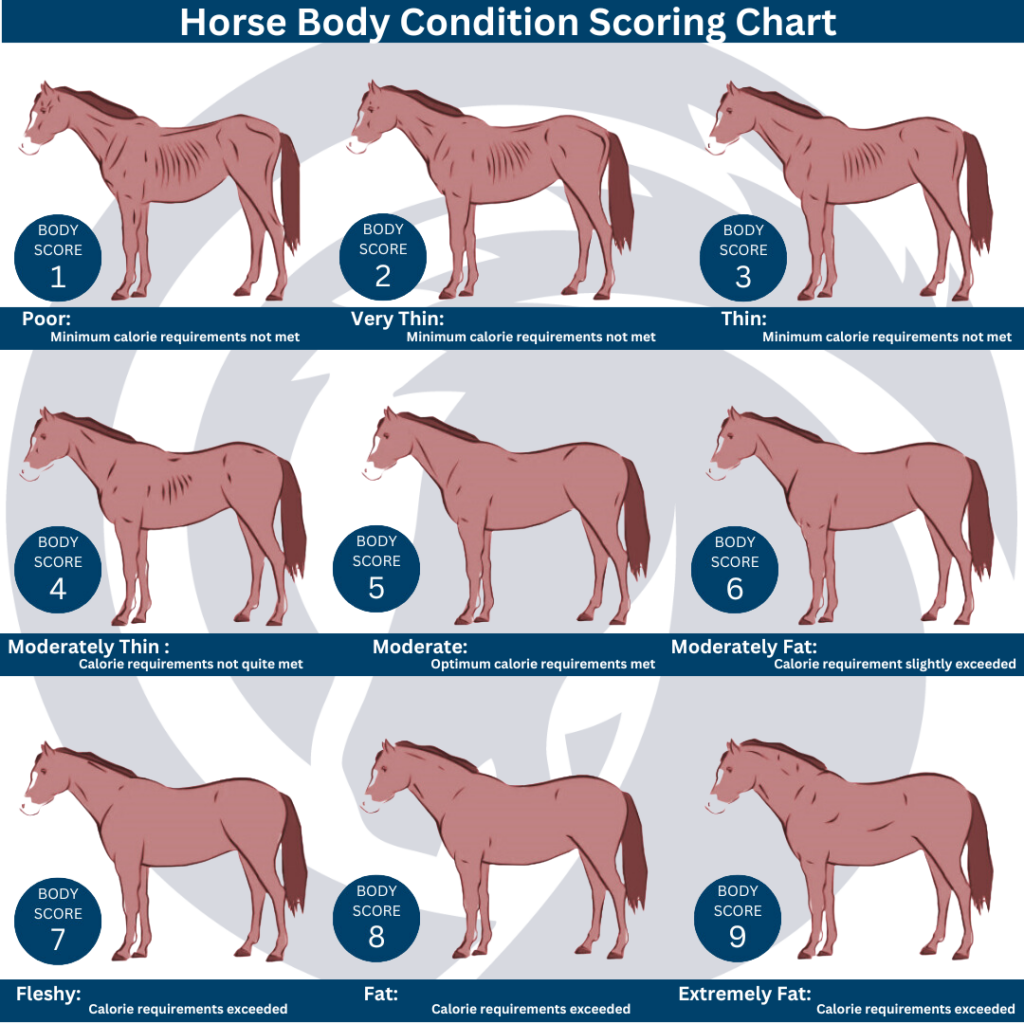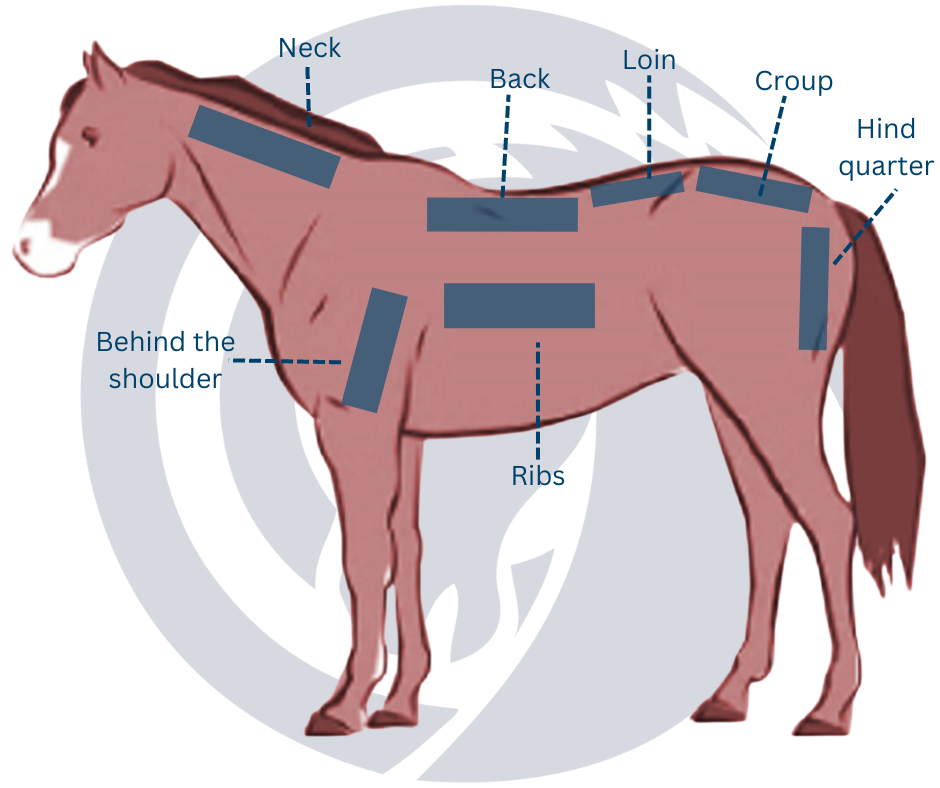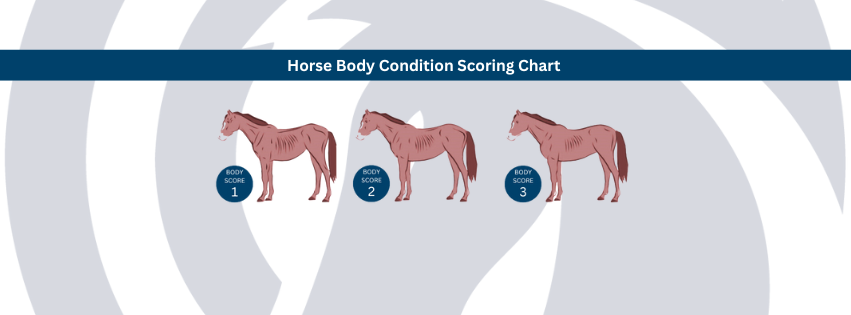Body condition scoring is a really useful tool for general horse and pony management.
It is a method which is used to assess a horse’s body condition and overall fat coverage. It is really important to monitor your horse or pony’s health and nutritional status, so you can get the maximum performance from your steed.
Following on from our guide on how to use a horse weight tape, we have written this guide to body condition scoring below.
Here’s our easy to follow guide on how to body condition score a horse.
Understanding the scoring system:
Horse body condition scoring is typically scaled from 1 to 9, with 1 being extremely emaciated and 9 being extremely obese. Each point on the scale corresponds to different levels of fat deposits and muscling.

- The horse is emaciated with the spine, ribs, top of the tail, shoulder and hips very prominent with little of no flesh covering them. No fatty tissue can be felt.
- Slight covering of flesh over the shoulder, spine and top of the tail. Ribs are very prominent. Hollow throguh the quarters, tucked up appearance in front of the stifle
- Hips and ribs slightly covered. Some hollowness through the quarters and tucked up. Top line undeveloped and an angular appearance.
- Outline of the ribs can be seen although they are covered. Neck reasonably well covered with some top line.
- Ribs should not be easily distinguished but can be felt. Well muscled top line, shoulders and neck blending smoothing into the body. Fat around the top of the tail and no hollowness through the quarters.
- A crease may be visible down the back. Fat over the ribs and at the top of the tail feels spongy. Fat deposits on the withers and behind the shoulders.
- A more obvious furrow down the back. Difficulty in feeling the ribs. Fat deposits on the neck and behind the shoulders are visible.
- A clear furrow along the back and fatty deposits around the tail, shoulders and ribs. The quarters will take on an apple shape and the neck will have a cresty appearance.
- Large fat pads along the ribs, shoulder, neck, top of the tail and the sides of the hind quarters. Obvious furrow down the back and the quarters will look very apple shaped.
What we would expect to see:
A healthy body score for most leisure horses and ponies is around 4.5 – 5.5. By allowing the extra point, it gives some adjustability we would expect to see for seasonal changes. Many horses lose weight over the winter and then gain it when the spring grass comes through.
Visual examination:
Stand your horse up, ideally on level ground and observe your horse from each side and from the rear. Please make sure you do not stand directly behind your horse if he or she is a bit flighty.
Assessing fat deposits:
Pay attention to the following areas when assessing for fatty deposits.

- Along the neck: Look for fat deposits along the crest of the neck. A horse with a higher body condition score will have more fat along the crest.
- Along the withers and the shoulders: Look for the amount of fat covering the wither and shoulders. Horse’s carrying too much weight will often appear very flat across their wither.
- Behind the shoulder: Note the amount of fat cover behind the shoulder, a horse with a higher BCS will have a smoother and rounder appearance.
- Along the ribs: Run your hand lightly along your horse’s ribs. A horse with an ideal body condition score, will have ribs you can just feel but will not be protruding, with a slight covering of fat.
- Along the back and loins: Assess the amount of fat covering the back and loin area. A horse with an ideal BCS will have a slight fat covering, giving a smooth appearance. If your horse has a furrow along his/her back, generally this means the horse or pony is overweight.
Evaluate Muscle Tone:
In addition to assessing the fat cover, evaluate the horse’s muscle tone. A horse with a body score condition of 5, will have well defined muscling without excessive fat deposits.
Score the Horse:
Based on your observations, using the techniques above, assign a body condition score from 1 to 9 for the horse. Remember to consider fat cover, muscling and overall appearance. It can be helpful to do a couple of horses or ponies to start training your eye.
Document and Monitor:
Record the body condition score and date it for future reference. Monitor any changes in the horse’s body condition over time to identify trends or to address any nutritional or health concerns.
Seek Profession Guidance:
If you are unsure about how your horse or pony is looking, please consult your vet, yard owner or equine nutritionist for help and recommendations. It might be as simple as a bit more hay or a bit less grass to get your horse on the right path to being fit and healthy.
Remember that in conjunction with a weight tape, regular body condition scoring helps horse owners track any changes in weight and overall condition, allowing for adjustments in feeding and management practices to maintain optimal health and performance.




